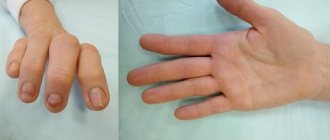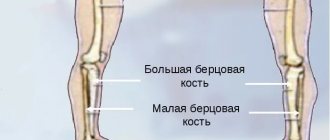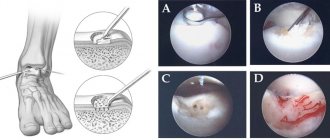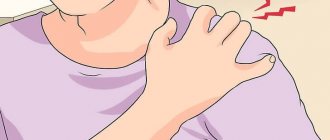Publication date: September 18, 2020
A broken big toe is a fairly common injury that a person can get while playing sports, at work, while walking, and even at home. Pain sensations differ from the severity of the injury and its size. For example, if we are talking about a fracture of only one nail phalanx, then it is quite easy to miss it or even confuse it with a regular bruise. And it is precisely because of the latter that a slight fracture can lead to quite serious consequences and improper healing. We strongly recommend that after a strong blow or injury, you can contact a medical center to rule out a fracture or begin its immediate treatment.
Signs of a broken toe
Depending on the location and severity of the fracture, symptoms can vary greatly. When a phalanx is cracked, pain is practically not felt, and the victim may not even be aware of the problem; very often the bone heals without plaster or fixation. When the first phalanx of a finger is fractured, severe, aching pain is felt.
When a toe is broken, the general symptoms are as follows:
- a hematoma forms at the fracture site;
- possible hemorrhage;
- the skin becomes dark blue, the skin around the damaged bone swells;
- severe and sharp pain with any attempt to touch or move a finger;
- unnatural mobility of the injured finger;
- inability to lean on the affected leg;
- immobility or partially limited movement of the finger;
- increased temperature and redness at the site;
- with a comminuted fracture, shortening of the finger is possible;
- with an open fracture, a wound with bone fragments;
- pronounced twitching or pulsating of the finger.
Upon physical examination, crunching of bone fragments is observed if little time has passed since the injury. The crunch is the result of the friction of broken bones against each other. Finger fractures are combined with damage to the ligamentous apparatus, sprains and dislocations of the phalangeal joints.
Posterior ankle fracture.
Most often occurs in combination with a fracture of the lateral malleolus or as part of a trimalleolar fracture. Surgical treatment is indicated when more than 25% of the area of the supporting plateau of the tibia is involved, and displacement is more than 2 mm. Most often, fixation with screws is used; if the displacement can be eliminated closed, the screws are installed from front to back; if open reduction is performed from the paraachilles approach, then the screws are installed from the back to the front; it is also possible to use an anti-slip plate installed proximally.
How can you distinguish a possible bruise from a fracture?
A bruise or fracture can be determined by several parameters:
- Features of the pain syndrome.
- Finger movement.
- Skin color at the site of swelling (bruise).
- Presence of hemorrhage.
- Phalanx shape.
The clinical picture of a bruised finger is as follows:
- The victim experiences sharp pain, which begins to subside over time. The nature of the pain is “aching.” Using a cold compress can speed up the process of relieving pain symptoms.
- When bruised, the finger is not deformed. Immediately after a bruise, all movements are accompanied by sharp pain (pulsation is possible); as the pain subsides, the motor activity of the finger is gradually restored.
- Depending on the nature of the bruise, the color of the skin at the site of the injury may be dark red, pink, or pale pink. Swelling may appear immediately, after a day, or not appear at all. The blood at the site of the injury spreads diffusely (scattered), a bruise may appear.
Ankle joint: how to treat dislocation and subluxation
If you experience joint pain
ankle, which means you most likely have a sprain or subluxation. It is necessary to consult a doctor so that he can correctly diagnose the injury and prescribe treatment. Otherwise, undesirable consequences for your leg are possible. For example, it may become very swollen or a dislocation will sooner or later lead to a fracture.
What is the difficulty?
The ankle joint includes three bones: the tibia, fibula, and talus. When they move relative to each other, a dislocation occurs. Just because your ankle is swollen does not mean you have a fracture. Most likely it's just a dislocation. But you still have to see a doctor for an accurate diagnosis. After all, even if there is no fracture, you still pulled the ligaments.
If an ankle injury occurs, you twist your leg, then it is usually hidden. But a situation is possible when it will be open. In this case, it is clear that you have a fracture. If the foot turns outward or inward, then, first of all, the ligaments are injured. In the first case, these are the fibula, and in the second case, the tibia. The foot will also be turned in one of the directions.
Damage level
How to properly brace the leg depends on the extent of the injury. There are several types of it:
- A sprain characterized by the rupture of individual fibers, since stretching the ligaments itself is impossible, because these are not elastic tissues. The ankle joint is usually swollen and painful. The patient can partially move.
- A tear characterized by swelling and hematomas. A person experiences pain even while lying on the sofa. It's very painful to move.
- Rupture if complete dislocation occurs. In this case, the leg moves noticeably. The patient cannot move his foot or step on it. The leg swells greatly and a hematoma is visible.
With subluxation, the integrity of the ligaments is in any case compromised. If a person is overweight, then such injuries will happen to him more often than to thin ones. The more and more often dislocations occur, the more dangerous it is for the leg, since the cartilage tissue is destroyed, which ultimately leads to arthrosis. It is for this reason that you should always consult a doctor, even if the injury is minor.
How to classify
Classification of dislocations:
- From the inside, if the ankle breaks from behind;
- Externally, if the fracture is external;
- Posterior injury, if the tibia breaks;
- Anterior, if the joint is injured, several fractures of the tibia occur.
The problem is divided into the following types:
- Combined, when several types of injuries occur at once;
- With ligament rupture;
- With an ankle broken in two or three places;
- Tearing or rupture of many ligaments, as well as dislocation of the joint.
If you do not start treatment immediately, or if you do it incorrectly, then problems will arise when walking, there will be a constant feeling of pain, and arthrosis will also develop. Therefore, it is necessary to immediately consult a doctor after injury. Especially if you suspect you have a dislocation or subluxation.
Causes of ankle sprain
The following problems may be the cause:
- A person may hit himself;
- A person may fall;
- Careless turn of the foot;
- A person may place their foot inaccurately;
- Weakening of tissues with age if you do not exercise;
- Underdevelopment of the tibia;
- With a high arch of the foot;
- Previously received sprain injury;
- Neuromuscular muscle disorder;
- Incorrect foot placement, resulting in weakened muscles.
If a person suffers from certain diseases, then he may experience discomfort, as his leg will constantly be dislocated. If you suffer:
- Tuberculosis;
- Diabetes mellitus;
- Oncological diseases;
- Obesity;
- Muscle paresis;
- Inflammation of ligaments or tendons;
- Pathology during development in the womb.
What are the possible symptoms?
If a person has experienced a fracture, a simple bruise or a dislocation of the ankle joint, he will feel approximately the same. It is impossible to stand on my leg; it swells and hurts even at rest. In order to exclude a fracture, they first take an x-ray, then, if it is a dislocation, they numb the leg and set the bone. For bruises and sprains, apply an elastic bandage.
Symptoms of injury:
- Swelling of the leg;
- Swelling of the foot, the more complex the injury, the greater it will be;
- Pain;
- Painful palpation;
- It is difficult to lift the leg, there is a feeling of discomfort.
Dislocation is usually accompanied by a crunching or clicking sound. The temperature of the damaged area of the body rises, and general malaise is possible.
How to help
A person who has suffered a dislocation needs to be given first aid. Start by removing your shoes and socks to improve circulation. This is the case if the injury is minor; in difficult situations it is better to leave everything as it is.
You need to place your leg on something soft and lift it up. The first day it is necessary to apply cold. To relieve severe pain, you can take analgin or similar medications from this group. Now call your doctor.
How to relieve pain
By applying a cold compress to the damaged area, you can reduce pain and also remove swelling. It is necessary to take anti-inflammatory drugs, for example, Ibuprofen, which relieve pain, you can use Pentalgin, and resolving hematomas, in particular, Troxevasin.
How to realign a joint
If you have sprained your ankle, then you should definitely visit an orthopedist.
The doctor must hear from the patient how the injury was sustained, as well as how he feels. After palpation, the specialist is convinced of the patient’s words by prescribing an MRI or X-ray. The joint is then realigned. This is done either by surgery or by palpation. The leg is pulled sharply towards itself, or under general anesthesia, the surgeon inserts the bone into place. Author: K.M.N., Academician of the Russian Academy of Medical Sciences M.A. Bobyr
How to diagnose a broken finger
- Upon palpation, the pain sharply intensifies and does not go away for a long time (an hour or two).
- When a fracture occurs, a sharp pain is felt, which can radiate to the nearest parts of the foot. Deformation of the phalanx, unnatural position of the finger. Swelling and strong (acute) pulsation at the fracture site.
- If there is a fracture, the victim cannot move the injured finger. Any attempt to stand on the affected leg causes the patient to experience severe pain. To relieve pain symptoms, the affected finger is fixed in one position.
- Hemorrhages form under the nail, hematoma and swelling appear, and the skin becomes bluish.
Briefly about prognosis and prevention
The most favorable prognosis is given for those intra-articular fractures that are characterized by the presence of a minimal number of fragments and the absence of displacement. A separate niche in the discussion of prognosis is occupied by the issues of joint endoprosthetics due to a severe fracture. However, artificial joints - even with good technical characteristics - cannot compete with the natural functionality of real joints.
Preventive measures are mainly aimed at early diagnosis of disorders that indicate the first signs of weakening bone strength. Currently, a diagnostic method is used, such as densitometry, which allows one to assess the degree of development of osteoporosis quite accurately, as well as the risk of pathological fractures, including intra-articular ones.
First aid for a broken finger
If you have symptoms indicating a possible fracture, there is no need to panic in the first place. The first thing you should do is call an emergency ambulance. Before the doctor arrives, all efforts of the victim should be aimed at stopping the bleeding (in the case of an open fracture), fixing the limb and anesthetizing the injury site. To prevent negative consequences, the following rules must be followed:
- even in the absence of pronounced symptoms, one should not refuse to consult a doctor;
- fixation of the limb is one of the main stages of effective treatment;
- the broken finger should not touch foreign objects;
- non-displaced fractures may not be fixed until the ambulance arrives;
- pain can be relieved with nimesil, analgin and ibuprofen;
- A cold compress is another effective way to relieve pain.
It is important to note that when applying an ice pack, keep the compress for no more than 10 minutes to prevent possible frostbite. A repeat procedure is possible after a 3-4 minute break. Even if you suspect a fracture, experts recommend immediately contacting a specialized medical institution for qualified help.
Features of the violation and location
To assess the severity of the damage, you need to understand the anatomical features of the bone. In the joint of the bone there is a cavity, which is formed with the help of a shell - the joint capsule. The latter covers the entire joint. If a crack or fragment occurs in this area, the articular capsule can completely hide the damaged area. Sometimes the crack extends beyond the shell - such an injury will also fall into the described category. There are also incomplete intra-articular fractures, which cause no less problems. The patient should visit a clinic that offers professional treatment of the spine and joints.
Treatment methods for a broken finger
| Name | Description |
| Closed reduction | This method is used for closed fractures and in the absence of displacement. Antiseptic agents are applied to the damaged finger, after which the doctor uses mechanical force (pulling) to return the finger to its normal position. A significant disadvantage of this method is the need to repeat this procedure. |
| Skeletal traction | This method is used for displaced fractures. This procedure requires a metal needle, which is passed through the finger with a small load, which allows the bones to be in a normal position. At the end of the procedure, the doctor performs immobilization. |
| Public Methods | The surgeon performs osteosynthesis. Secures bone fragments with special metal elements. The broken parts of the bone are united and its correct shape is restored. Open reduction is performed for all open and comminuted closed fractures. The operation also eliminates complications that arose during the treatment. |
| Surgical intervention | The operation is indicated for patients who have an open fracture of the big toe or in case of crushed phalanx. During surgery, the doctor restores the physiological position of the finger. To fix fragments, knitting needles, plates, and screws are used. |
Injury
A common bruise is the result of a foot hitting a hard object. In this case, as a rule, serious destruction of body tissues is not observed. Bruises of the lower leg and ankles are very painful, since the bones in this area are devoid of protective fatty cover. Recovery from a minor injury is often quick. Extensive damage can cause massive swelling, hematomas, or even injuries to blood vessels and nerves. However, more often than not, a “regular” bruise will involve only moderate pain and minor swelling.
What injuries may be
A fracture, bruise, sprain or even ligament rupture have a number of differences. But in general terms, any damage is not pleasant and can cause similar pain, therefore, to clarify the diagnosis, you need to contact a specialist - he will determine exactly what befell the patient.










